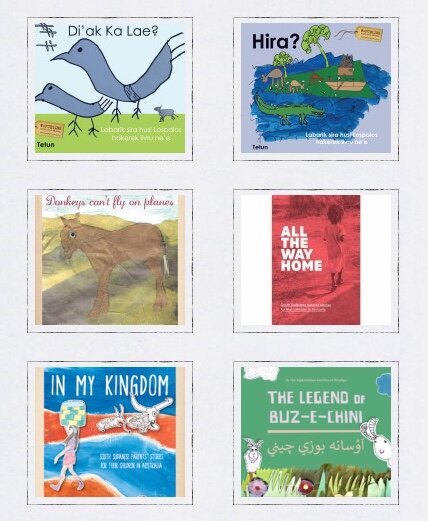BLM & books by children
Why We Need Diverse Books
From the Kids’ Own Publishing library
I wanted to respond to the Black Lives Matter movement in this space, and the role publishing books with children as authors plays in taking up this message loud and clear. At Kids’ Own Publishing, the organisation I founded, we very much shared the stated mission of the movement Why We Need Diverse Books: A world in which all children can see themselves in the pages of a book https://diversebooks.org/about-wndb/
A key driver for creating opportunities for publishing books with children as authors is so they see themselves and their lives reflected in the books that they read. Not only does this recognition make the literacy journey easier and more meaningful, but it can have profound impacts on children’s wider confidence in their communities (Schreger & Pernes, 2015), and give rise to inspiring material intra-actions in the entangled multimodal process of making (Zapata & Van Horn, 2017).
In 2019, the Centre for Literacy in Primary Education in London published its second Reflecting Realities report citing that only 7% of books published in the UK in 2018 had leading characters of colour (up from 4% in 2017!). In a Guardian article about the report, children’s author, Kiran Millwood-Hargrave said that books, while commonly seen as windows, “must also be mirrors, a way of examining the world as it is and could be.” She adds that “Diversity is not a buzzword; it is a fact and strength of our society, and it’s time our writing culture reflected that.”
(Flood, 2019)
A significant proportion of books by and for children that I published over the last 30 years had cultural identity and bi/multilingualism as their driving purpose and have reflected diverse ethnicities. (It will be interesting to note how this picture compares with my survey respondents.) I have often argued to funders and others in the past that publishing with children in their communities is a relatively inexpensive means of resourcing schools and libraries with books in their local community languages, particularly minority ones. A few of them can be seen here .
I agree with award winning UK author Onjali Raúf, , “Children’s books are lifelong touchstones, and carry messages that ingrain themselves deeply in ways we are only now beginning to understand. Any act to enhance empathy and understanding, do away with the ‘other’ and help diminish fears and prejudice has to begin early. It is utterly crucial that cultures, voices and characters from all spectrums be gifted to us.”
And while we’re about it, why not also hear straight from the children themselves?
Flood, A. (2019, 19 Sep 2019). ‘What’s taking so long?’: children’s books still neglect BAME readers, finds study. The Guardian. Retrieved from https://www.theguardian.com/books/2019/sep/19/whats-taking-so-long-childrens-books-still-neglect-bame-readers-finds-study?CMP=Share_iOSApp_Other
Schreger, C., & Pernes, S. (2015). The big world of 'little books' In C. Hélot, R. Sneddon, & N. Daly (Eds.), Children’s literature in multilingual classrooms: From multiliteracy to multimodality (pp. 154-170). London: Institute of Education: Trentham Books.
Zapata, A., & Van Horn, S. (2017). "Because I'm smooth": Material intra-actions and text productions among young Latino picture book makers. Research in the Teaching of English, 51(3), 290-316. Retrieved from http://search.ebscohost.com/login.aspx?direct=true&db=eue&AN=121657308&site=ehost-live
-
June 2022
- Jun 27, 2022 Micropublishing using KidsPublish app Jun 27, 2022
-
October 2020
- Oct 12, 2020 A Tasmanian Book Cubby Oct 12, 2020
-
September 2020
- Sep 1, 2020 BLM & books by children Sep 1, 2020
-
June 2020
- Jun 17, 2020 All emotions… Jun 17, 2020
-
May 2020
- May 27, 2020 Ripples May 27, 2020
